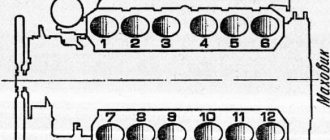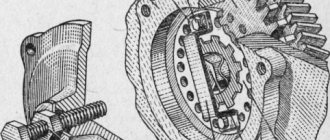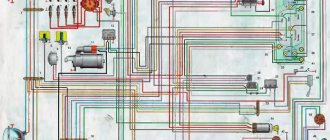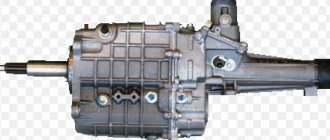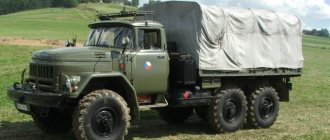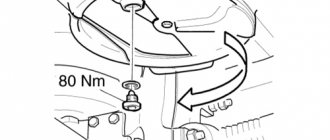Adjusting the ignition of YaMZ 238 - how to set
On all engines, without exception, early ignition is set. Adjusting the ignition of the YaMZ 238 is no exception. This is done so that at the moment of compression at top dead center the fuel is already ignited.
Compression at TDC causes a maximum increase in the pressure of already burning fuel, resulting in the highest engine efficiency and more complete combustion of the fuel. Ignition advance should occur 10-12 degrees of crankshaft rotation before the piston reaches top dead center at the moment of compression. Both 15 degrees and 18 are allowed, depending on the operating conditions of the engine.
YaMZ engines have three scales on which the crankshaft rotation angle is indicated. On the flywheel, on the drive belt pulley and on the right side there is a hatch, when opened, a scale will appear. It is most convenient to look at the flywheel, if, of course, the engine is installed on the car.
Now it is necessary to bring the piston of the first cylinder to the top dead center at the moment of fuel compression. This is very important to understand because the crankshaft makes two revolutions during a full working cycle, that is, the scale appears at top dead center twice.
You can navigate by external signs; when the crankshaft rotates, the valves of the first cylinder must close before the piston reaches top dead center; this will be the compression moment in the second position when the piston reaches TDC; one valve closes; the second, after passing TDC, opens; this is clearly visible from the rocker arms.
But it’s easier to determine by the mark on the fuel pump because it makes one revolution and the aligned marks indicate the correct position of the piston.
And so, after the marks on the pump approximately coincide, we open the hatch to the flywheels. There we will see a scale, which we set to 10 - 12 degrees.
Then, on the fuel pump, loosen the adjustment bolts, also known as the mounting bolts, and align the mark on the fuel pump body with the mark located on the coupling.
Then tighten the bolts with great effort. All ignition is set. Adjusting the ignition of the YaMZ 238 is not very difficult. But it allows the engine to operate in its normal mode.
Source
Procedure for setting the injection advance angle
The designers of turbocharged systems have taken care of the convenience of setting ignition parameters on heavy-duty engines - two holes can be found on the flywheel housing. The part itself bears marks that help set the angles. It looks like marks on the flywheel, equipped with numbers from 5 to 20 with an interval of 5° (on the lower indicator) and marks with letters from A to G (on the upper crankcase indicator).
To adjust the injection advance angle, open a hole in the housing and rotate the crankshaft until the notches on the pulley and timing gear housing are aligned. In this case, the obtained value should correspond to 6-7° - the setting parameter for the injection moment. When the shaft is rotated, the valves in the first cylinder must be closed.
To ensure correct adjustment and uninterrupted operation of the unit, you must carefully perform the following sequence of actions:
- check how tightly the coupling half is seated on the drive shaft and tighten the terminal bolt;
- unscrew a pair of bolts and rotate the clamping device through special holes until marks A and B on the damper coupling are aligned;
- tighten the fasteners on the drive;
- take measurements in the areas where the plates are attached (permissible deviation +/- 1 mm);
- turn the crankshaft and check that the fuel injection advance angle is set correctly (the error is one division or 1 degree of shaft rotation);
- measure the oil level in the clamping device;
- carry out actions to check the parameters of the injection advance angle.
You can check how well the YaMZ 238 turbo engine can perform its functions after adjusting the ignition and check the sufficiency of oil by installing the coupling with the holes facing up and removing the plugs. When turning the clutch until an angle of 70 degrees is reached, oil should come out of one of the holes. If necessary, add oil and then return the plugs to their place.
If the plunger pairs are significantly worn, this method of setting the injection angle may produce an error. Therefore, methods using analyzers, a strobe, and a diesel tester are often used.
Why do you have to adjust valves?
The valves on the Yamz 238 engine are adjusted for various reasons. The engine is working properly. As a result of friction of the parts of the gas distribution mechanism, the gaps increase. Adjustment allows you to reduce the gaps to working condition. Seats and valves wear out and clearances decrease.
Therefore, every 10,000 - 20,000 km it is necessary to check the size of the thermal gaps. In addition, engine breakdowns occur. The cylinder head will be removed. Rocker arms are being repaired. The cylinder head gasket is being replaced. After repair, it is also necessary to adjust the valve clearances.
YaMZ engines, while they are new, seem very reliable and powerful. It seems that this engine can never break down. But this is only the first impression. Then he creates one problem after another. These are sagging liners, leaking coolant from under the rubber seals of the liners and other reasons. There are a lot of them when you have to remove the block head. After the repair is completed, the problem of valve adjustment remains.
Of course, experienced motorists can easily cope with this; for them it is not a problem at all. Where can I find a mechanic if my car breaks down in a field or on the highway? And it can be simply a pity to give extra money, in principle, for an insignificant service. Therefore, it is better to figure it out yourself once and not count on anyone.
When adjusting valves, you need to know the operating order of the engine cylinders. In order to understand which cylinder valves should be adjusted next.
all about YaMZ (questions and answers)
Message from SERGEIDV
Message from Sergey11113
Message from Sergey11113
it is said: “For in the scripture. “, but don’t trust people! cpg. ) you don’t have to look at the pulley, remove the lower hatch of the flywheel housing and go ahead. 15 degrees is about 238BE, but the principle is the same
The order of operation of the YaMZ 238 engine cylinders
All V-shaped eight-cylinder engines operate in this order. This means that the piston of the first cylinder has approached TDC at the moment of compression. Fuel has been injected into the combustion chamber of the first cylinder. The valves of the first cylinder are closed. And it is in this position, with the engine not running, that the valves of the first cylinder can be adjusted.
Cylinder 5 will start working next according to the engine operating order. The piston of the fifth cylinder will approach TDC and fuel injection will occur. The valves will close at this moment. This position will be used to adjust the valves of the fifth cylinder. Etc. The remaining cylinders will operate in accordance with the order. That is, it is necessary to bring the piston of each cylinder to the top dead center in turn according to the operating order.
How to check the accuracy of the fuel injection value
The discrepancy in readings should not exceed 1°. To check the accuracy of setting the feed advance angle on the YaMZ-238 you need to:
- Place the fixing element from the recess on the flywheel without securing it in the upper position.
- Rotate the crankshaft one and a half turns.
- Rotate the crankshaft moderately and observe the fuel in the glass chamber of the measuring device.
When the fuel begins to move in the chamber, the marks on the rotary wheel casing should coincide with the digital value indicated on the end part of the OVT coupling. Or the notch on the crankshaft impeller should be opposite the mark with a similar number on the camshaft housing.
If at the beginning of the movement of fuel in the chamber the marks have not yet coincided, you need to unscrew the fastening bolts, then rotate the motor shaft coupling half on the flange in the opposite direction of torsion, tighten the fastening bolts back, and again check the position of the fuel injection advance angle.
The steps above must be performed with special equipment. If there is not enough experience, knowledge and material and technical base to correctly set the engine ignition and regulate the fuel injection pump, it is better to turn to professionals with this issue. Incorrectly installed fire protection equipment is the cause of serious, expensive and, often, irreparable breakdowns.
How to install the piston of the first cylinder
The most important. It is necessary to set the piston of the first cylinder to TDC at the moment of fuel compression. That is, determine the position of the piston of the first cylinder at which it is necessary to begin adjusting the valves. It's very simple. The marks on the injection pump are aligned.
This position will be sufficient to begin adjusting the valves. True, the piston will not be perfectly at TDC. Lower by the ignition timing. That is, it will not reach TDC a little, but this will not affect the adjustment in any way. The valves are closed, and they can be adjusted.
The crankshaft also has marks. And if you put them out. The piston of the first cylinder will be at TDC. But the crankshaft makes two revolutions and the fuel injection pump makes one revolution for a full cycle of engine operation. Therefore, in one of the positions of the crankshaft marks, the piston of the first cylinder may not rise at the moment of compression. Therefore, it is safe to navigate by the position of the fuel pump. Or on the valves, if the fuel pump is removed. At the moment of compression, when the piston approaches TDC. The exhaust valve of the first cylinder is closed and the intake valve is closed. With further rotation of the crankshaft, until the piston reaches TDC. The valves are closed and the rocker arms are motionless. In the second position of the crankshaft marks, one valve closes before TDC, and after the piston passes TDC, the second valve immediately opens. This position of the piston is not satisfactory. After the piston of the first cylinder is set, the valves of the first cylinder can be adjusted.
How to crank the crankshaft
The next question is how much to crank the crankshaft. and in which direction to adjust the fifth cylinder. According to the operating order of the engine. As mentioned above, the crankshaft makes two revolutions. That is, one revolution is 360 degrees, two revolutions are 720 degrees. 8 cylinders divided 720 by 8 gives 90 degrees. That is, from adjusting the first cylinder until adjusting the 5th cylinder, the shaft must be turned 90 degrees, that is, ¼ turn. To make it easier to navigate, you can put chalk marks on the pulley. Divide the pulley into 4 parts.
Great precision is not required. And each time rotate the shaft until the mark on the pulley aligns with the “0” mark on the front cover. So from the first to the fifth 90 degrees, from the fifth to the fourth 90 degrees from the fourth to the second 90 degrees and so on until the eighth cylinder. The crankshaft must be turned clockwise when looking at the end of the engine from the front. The method is very simple but not convenient. When the engine is on the car, it is difficult to get to the pulley. Moreover, mark it. And then it’s even more difficult to combine these marks. Soviet designers were far from stupid people. All aspects were taken into account in the calculations. Therefore, the instruction manual suggests a simple method that does not require much knowledge and memorization.
In-line engines
Over the course of its history, the YaMZ-530 family has produced more than 200 engine variants, although the plant sought to unify them as much as possible. Of these, the most relevant for freight transport are the 6-cylinder YaMZ-536 engines, currently modified to comply with Euro-5 environmental standards.
Our experienced mechanics will quickly find the fault, set the ignition or rebuild the engine 8-999-999-90-24
The engine of this series already uses 4 valves per cylinder, and their traverse drive is used - both intake and both exhaust valves are controlled from their camshaft cam through a common rocker arm, pressing on the valve stems through the traverse. Therefore, the scope of adjustment work does not change. The procedure itself is typical for power units from Yaroslavl: the adjusting screw is installed on the rocker arm on the rod side.
It is necessary to take into account that the yoke can swing relative to the rocker arm, so the feeler gauge is placed not on the valve stems, but between the yoke and the rocker arm cup - the adjustment screw is installed so that the yoke provides a clearance in the valves at the inlet of 0.3 to 0.4 mm, at the outlet – from 0.4 to 0.5 mm.
YaMZ-650 engines were created on the basis of a license purchased from Renault Trucks; serial assembly has been carried out since 2007. This family of inline 6-cylinder engines also features 4 valves per cylinder with traverse drive. To rotate the crankshaft during the adjustment process, the factory technology requires the use of a special device installed in the lower access hatch in the flywheel area of the crankcase. The clearances for each pair of valves are set simultaneously using the rocker arm adjusting screw on the rod side. The gap at the inlet is 0.35...0.45 mm, at the outlet - 0.65...0.75 mm.
Factory method for adjusting YaMZ 238 valves.
The operating manual suggests setting the piston of the first cylinder to TDC at the moment of compression. In the same way as already written. Adjust the valves of the first cylinder. Then go to the fifth cylinder. Start rotating the crankshaft. The exhaust valve of the first cylinder is already closed. The intake valve rocker arm moves and at some point the intake valve closes and the rocker arm becomes stationary. At this point, you can turn the crankshaft a little more. Only to make sure that the valves are closed and the rocker arms are motionless.
In this position the valves can be adjusted. The shaft should rotate approximately 90 degrees, but this is not very important. Next, we move to the fourth cylinder and also turn the shaft until the inlet valve of the fourth cylinder closes. After the valves closed and the rocker arms became motionless. We adjust the valves of the fourth cylinder. Then we move on to cylinder 2 and so on until cylinder 8. It doesn't seem very accurate. But it's actually very practical. There is no need to crawl under the engine and look for flywheel marks. It is enough that the marks on the fuel pump aligned when the piston of the first cylinder was installed.
Ignition installation
Ignition installation is the process of adjusting and controlling fuel injection.
You can set the ignition of YaMZ 236 m2 yourself or with the help of service station specialists. The adjustment must be made as follows:
- find the mark on the coupling near the fuel pump and fix the part with this mark facing up;
- turn the engine to get a value of 20 degrees on the scale;
- loosen the bolted connection fixed on the coupling, turn it to the late ignition position;
- unscrew the tube supplying fuel to cylinder No.1;
- wipe parts and remove dirt;
- Rotate the clutch slowly until fuel is visible in the recess located on the primary cylinder;
- tighten the bolts on the coupling.
Adjusting the YaMZ 238 valves in two revolutions of the crankshaft.
It consists in the following. As in all the described cases, the piston of the first cylinder is set to TDC at the moment of compression. But it is set more accurately according to the crankshaft marks. The fuel injection pump mark is first aligned, then the mark on the pulley is aligned with “0” on the front cover. And the valves are adjusted according to the diagram
Then the crankshaft rotates one revolution, that is, 360 degrees. The marks of the crankshaft pulley or flywheel are again set to “0” and the following valves are adjusted.
But where does this save a lot of time? It's not entirely clear to me. The crankshaft also rotates two revolutions. Maybe fewer approaches. More precise alignment of the crankshaft is required. Which is also not very profitable. Climb under the car and look for marks that are clogged with dirt or simply cannot be read. And you won’t be able to remember this diagram and keep it in your head until the next adjustment. According to the law of meanness, she will not be at hand at the right moment.
Therefore, it is better to forget this method and never use it. There is less rotation of the shaft, and much more fuss. Due to the abundance of information, valves can simply be confused. Let's leave this method for very smart drivers. Which then will still remake the valves differently. If MMZ for the D 240 engine offers valve adjustment in two turns. Yes, it’s convenient and accurate. Kamaz and YaMZ don’t say anything about this and there’s no point in getting into the weeds. The designers know better. It is important for them that the engine runs for a long time. The motor does not forgive even minor mistakes.
Injection accuracy assessment
The spread of indicators should be no more than 1 0. To evaluate the injection accuracy indicator, you need to:
- A fixing part is installed from the dart on the flywheel. There is no need to fix the top positions.
- The shaft rotates one and a half turns.
- The shaft is rotated carefully, assessing the condition of the fuel in the compartment.
When the fuel begins to move, you need to make sure that the indicator number on the flywheel case coincides with the indicator number indicated on the OVT coupling. If discrepancies are detected, the clamps are unscrewed, and then the coupling on the edge rotates in the opposite direction. Then the clamps return to their original position, and the injection angle is assessed.
Ideally, setting the injection angle should be done using special equipment by professional craftsmen. Carrying out this procedure on your own is not easy. If the ignition operation is incorrectly assessed, undesirable consequences may occur that will be difficult to correct.
Valve clearances YaMZ 238
Adjusting the valves on the YaMZ 238 involves setting the gaps in the range of 0.25-0.3 mm. The intake and exhaust valves have the same clearance. If a 0.25 mm feeler gauge is installed, it should fit between the rocker arm and the valve neck without much effort, freely. If you install a 0.3 mm probe. it should enter with force, but not so much that it does not fit between the valve and the rocker at all.
After the valves have been adjusted. It is advisable to start the engine with the valve covers open. This is necessary in order to check the repairs that were made before adjusting the valves. It is necessary to check the fuel pipes for possible fuel leaks. If there is a leak, fuel will enter the crankcase. And it doesn’t hurt to just check it again.
Source
Fuel supply advance angle. Installation
YaMZ-238 (motor photo) is a unit that has an advance value located near the hazard, located on the clutch housing (from the end) of the injection advance. These are numbers or 20, otherwise 18. If we are talking about the injection advance angle, then, you know, it is recognized by the first cylinder. There is an option to check using a manual booster pump. This device is used to pump fuel into the engine power supply system, making sure to loosen the plugs on the injection pump body through which air is removed before any manipulation. When there are no air bubbles left in the fuel coming out from under the plugs, you need to tighten the plugs. Next, you need to attach a torque scope to the fitting corresponding to the section of the fuel pump. Before the procedure, it is necessary to remove the high pressure tube of the first cylinder.
Engine YaMZ-238: Valve adjustment
The majority of MAZ drivers encounter valve adjustment on the YaMZ-238 engine. Only those who service their car exclusively at service stations avoid this operation.
Quite a lot of recommendations and instructions have been written on valve adjustment: from the simplest and most straightforward to musical. Professional mechanics adjust the valves by ear and by listening to the knocking sound that occurs when choosing a free gap. There are also people who adjust valves by eye.
In fairness, it is worth noting that such adjustment options, if used by a real specialist, give good results when setting gaps. However, I will not describe such methods, because... I don’t have such abilities, so I use a probe.
Consequences of incorrect injection timing adjustment
In conclusion, it is worth noting that it is advisable to carry out the above actions regarding adjustment of YaMZ engines with the proper level of training. In addition, you need special equipment that allows you to adjust engine parameters with the required accuracy. Insufficient qualifications and homemade devices can not only aggravate the situation, but also lead to irreversible engine damage.
One of the most common consequences of incorrect actions in relation to the motor is a reduction in the operating life of the unit. Lack of professionalism also entails a decrease in engine power and excessive fuel consumption. Therefore, it is important to correctly interpret the signs characteristic of early or late ignition.
When igniting early, the engine feels harsh, there is an unpleasant ringing and copious amounts of white smoke. Late ignition is characterized by increased smoke, reduced engine thrust, overheating of the power unit and incorrect engine speed along with vibration.
Experienced drivers are able to quickly determine the moment when ignition installation is necessary. Beginners should contact specialized repair centers as quickly as possible: ignition adjustment, as well as installation of such a part as the secondary shaft of the YaMZ 238 gearbox, should be performed by specialists with experience and the necessary equipment.
Reasons for adjusting valves
When should valves be adjusted? A knock in the gas distribution mechanism immediately comes to mind. It is clear that with such symptoms, first of all, the thermal gaps are checked and adjusted.
It is also worth making adjustments if the first thousand kilometers have been passed after the repair or if the cylinder head has been pulled.
It is necessary to monitor the mileage of the car and the condition of the entire gas distribution mechanism. If necessary, adjust valve clearances after 10-20 thousand km and always remember that increased thermal clearances lead to increased fuel consumption.
Design features of Yaroslavl diesel engines of the 238 series
The design of YaMZ-238 diesel engines assumes the presence of eight cylinders arranged in a V-shape. The volume of the combustion chambers is 1858 cm3 each. The diesel engine is a four-stroke type, with the cylinders operating in a 1-3-6-2-4-5-7-8 pattern. The power unit is equipped with a direct fuel injection system, and the compression ratio is 16.5.
The cylinder-piston group consists of a silumin piston complete with a cast iron liner. The CPG is attached to a cast iron connecting rod equipped with a bronze insert. The connection is made using a floating pin in combination with locking rings. The opposite end of the connecting rod is secured to the crankshaft journal with bolts. In this case, bronze sliding bearings are used.
The arrangement of cylinders in the units is two-row. There are four cylinders in each row. A separate cylinder head is attached to each row. Common to the two cylinder heads is a gear-driven camshaft. The crankshaft is equipped with counterweights and has 5 support points.
Gray cast iron is used as the material for casting the engine cylinder block. The casting of the main solid part that unites the cylinders of the unit is carried out in conjunction with the upper part of the housing. Modifications of cylinder blocks of YaMZ units produced before 2008 and currently are somewhat different: the “skirt” is somewhat shortened, and the engine itself has undergone certain modifications.
The engine flywheel is made of steel and has a ring gear that provides starter starting. The fuel supply system is a plunger type, mechanical. The fuel supply to the injectors is provided by the fuel injection pump of the YaMZ 238 engine. The engine cooling process is implemented through a water system and oil lubrication.
Adjusting the valves of the YaMZ-238 engine
Now, I will describe the adjustment procedure that I have developed. First of all, put the car on a flat, clean place and take out the tool. Raise the cab and unscrew the valve covers.
It happens that some wing bolts do not want to be unscrewed by hand, then we take a gas wrench or a large open-end wrench. With this problem, the 55 wheel hub wrench, which came with the tool kit for the car, helped me a lot.
Next, take a 30mm spanner with a power amplifier and climb under the front of the car. If the valves on the car are being adjusted for the first time, then we also take a triangular file with us.
We look for the injection mark of the 1st cylinder on the crankshaft pulley and on the front part of the pulley facing the radiator, file the mark opposite the mark of the 1st cylinder.
Then, we make another mark diametrically opposite the first one, and also at 90 degrees to the first two marks, and place two more marks. Thus, we divide the pulley into four parts at an angle of 90 degrees.
Now, we proceed to setting the first factory mark at 18 degrees and this place on the front plate should be marked out with at least chalk, because it will still be useful.
We climb out from under the car and check whether the valves of the 1st cylinder are clamped. You can also verify this by looking at the mark on the fuel pump, then it will become clear whether we have cranked the engine accurately and whether the injection is on the 1st cylinder.
At first, I did this too, and if it turned out that the injection was on the 6th cylinder, then I climbed under the car again, cranked the engine one more revolution and started adjusting from the 1st cylinder in the order of engine operation 1-5-4-2-6-3-7-8
.
Having adjusted both valves on the 1st cylinder, we climb under the car and rotate the crankshaft so that the second mark on the pulley is opposite the injection mark of the 1st cylinder on the block. Thus, we have turned the crankshaft exactly 90 degrees and we can go to the left bank of cylinders and adjust the next 5th cylinder in order.
Then, we climb under the engine again, turn the crankshaft another 90 degrees until the marks coincide and adjust the valves of the 4th cylinder on the right side of the engine. Next, we simply repeat the process for all remaining cylinders in accordance with the operating order of the engine.
Differences between YaMZ turbocharged diesel engines
The need to increase the power of the diesel engine led to significant modifications to key components.
The characteristics of the crankshaft were changed, the structure of the cylinder block and CPG was modified. The power units of the YaMZ-238 family have acquired a system with pressurized air through a turbine. The main element of the system is a turbine installed in addition to the engine. To confidently comply with Euro-1 standards, turbocharged diesel engines of the 238 series received a liquid-oil heat exchanger, a high-performance water pump, and the CPG was supplemented with an effective cooling system. Plus, the diesel engine was equipped with a charge air cooling system and an improved fuel system.
Diesel units YaMZ-238 Turbo, corresponding to the Euro-0 standard, are essentially the same forced engines YaMZ 238 M2. One of the main design features compared to atmospheric modifications is the YaMZ 238 turbine in an improved version.
Further improvement of turbocharged diesel engines for heavy trucks made it possible to create structurally new components that comply with Euro-2 standards - this is how a series of Yaroslavl DE engines arose. The main feature of these models was a modified high-pressure fuel pump.
Despite solid work on improving the "heart" of the truck, some parameters require adjustment in accordance with the characteristics of the vehicle and its features. One of the most important tasks for the correct and safe operation of a heavy truck is the correct setting of the injection (ignition) timing on diesel engines.
The presence of a turbine - a unit capable of increasing engine power by more than 50% - requires a special approach to the selection and installation of individual mechanisms. Thus, the turbine on the MAZ YaMZ 238 is most often used of the TKR 9-12 type, as well as similar modifications. Such injection systems are capable of working with most engines of the YaMZ 238 series without any particular difficulties. Productivity in this case reaches a level of 0.25-0.35 kg/s at a rotor speed of up to 50 thousand revolutions per minute. There are also similar models of Czech-made turbines.
